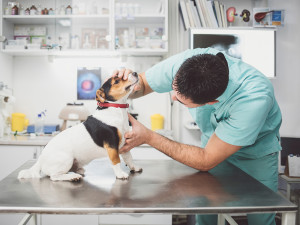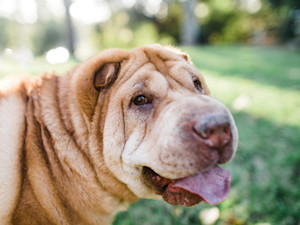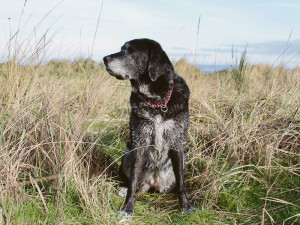Understanding Haemangiosarcoma In Dogs: Blood Vessel Cancer In Dogs
A common canine cancer, explained

share article
There are a lot of conditions that can bring a pet parent to the vet, but cancer is the worst. The best thing for everyone – dog, vet and pet parent – is a little preparation. Knowing what you should be looking out for in your dog will make it easier to make a decision when it comes to recognising an emergency. That means a better outcome for your dog even in difficult circumstances.
Haemangiosarcoma in dogs is a form of cancer that gives very few warnings. These fragile, blood-filled tumours are often not discovered until they rupture. At that point, emergency surgery is the only treatment option, so don’t delay and learn what to expect below.
What is haemangiosarcoma?
Haemangiosarcoma is one of the five most common types of canine cancer, including mast cell tumours, canine melanoma, canine lymphomaopens in a new tab and osteosarcoma. Haemangiosarcoma tumours develop from cells lining the blood vessels.
Since the body is laced with blood vessels, a haemangiosarcoma can appear anywhere. However, around 50 percent of the time they are found in the spleen. The next most common spot is the liver, then the heart. Very rarely, they’re found on the skin. This form of cancer is quite aggressive cancer and is most commonly found in middle-aged to older dogs, and slightly more often in males. It’s not clear why dogs develop this form of cancer, but when haemangiosarcomas are found on or under the skin, there is sometimes a correlation to sun exposure on thinly-haired spots, like the belly, inner thighs and eyelids. So your dog might need some shade, too.
Are certain breeds predisposed to haemangiosarcoma?
Golden Retrievers, German Shepherds, Portuguese Water Dogs, Boxers and Skye Terriers are the most commonly affected breeds by haemangiosarcoma cancer, so if you are the owner of one of those breeds, stay especially aware of their energy levels and skin. Vigilance is the best support for your dog.
Signs and symptoms of haemangiosarcoma
As stated above, it is hard to detect these tumours, but there are definitely some signs to be vigilant about. A tumour on or under the skin will often look like a dark red or purple bump that may bruise or bleed. For internal tumours, early signs may be as subtle as lethargy and pale gums.
A haemangiosarcoma develops slowly to start, but as it grows, the blood vessels supporting it begin to leak, resulting in blood loss into the abdomen. That’s when symptoms become more pronounced: weight loss, decreased appetite, increased panting, weakness, cough or a bulging belly. If your dog is suddenly weak and has a swollen or pendulous abdomen (protruding belly) or pale gums, it may be caused by their spleen rupturing and haemorrhaging.
How is haemangiosarcoma diagnosed?
When you see a suspicious skin mass, meaning one that’s larger than a pea or which has been lingering for over a month, get it checked out. A vet will perform a biopsy to procure a sample. But when an internal tumour is suspected, this method is much trickier. Instead, diagnosis usually involves blood tests, an abdominal ultrasound, X-rays and a CT scan.
How is haemangiosarcoma treated?
Surgery and chemotherapy are the most common treatments, although a haemangiosarcoma is likely to have metastasised by the time it’s diagnosed. A possible exception is a haemangiosarcoma in or under the skin because the pet parent is much more likely to notice it early. The principal goal of treatment is to slow down or delay the spread of the tumour and prevent life-threatening bleeding episodes. Currently, the prospect of a cure, or even a remission, is extremely unlikely for a dog suffering from haemangiosarcoma.
When a haemangiosarcoma ruptures
A spleen mass that ruptures requires surgery to remove the spleen. While the surgery can be life-saving, if the mass is a haemangiosarcoma, it will have already metastasised microscopically. However, not all spleen masses are cancer – approximately 50 percent of bleeding masses on the spleen may be benign. Vets may recommend a splenectomy and pathologic evaluation of the spleen, though it may only give the dog a few more months of quality life if the mass turns out to be a haemangiosarcoma. Within three to four months, the dog will have multiple tumours throughout the lungs and other parts of the body.
Advanced treatments for haemangiosarcoma
A 2012 study undertaken at the University of Pennsylvania reported success with an extract of a medicinal mushroom, Coriolus versicolor, in extending the lives of 15 Golden Retrievers with haemangiosarcoma. The mushroom contains a compound called polysaccharopeptide, or PSP, which some studies have suggested has both immune-boosting properties and a tumour-fighting effect. It has no side effects and is relatively inexpensive. However, to date – probably due to a lack of research – it’s rarely suggested or used by veterinary oncologists.
Currently, it’s estimated that a dog who tests negative for haemangiosarcoma has a less than one percent likelihood of developing it over a six-month period, while more than 90 percent of dogs with a positive test require further evaluation.
Disclaimer alert: this article is here to share information and should not be taken as fact or medical advice. Always talk things over with your vet when making decisions, and use your best judgement.
Susan Tasaki
Freelance writer Susan Tasaki lives in the San Francisco Bay Area with her Husky, who wishes they both got out more.
Related articles
![woman with red hair holds senior Pomeranian dog]() opens in a new tab
opens in a new tabSenior Dog Care
Is your dog getting older? As dogs age, it’s important to recognise both physical and mental changes they may be experiencing and learn how to cater to those needs
![Brown Dachshund dog wearing a gray and white striped handkerchief and laying on blankets]() opens in a new tab
opens in a new tabStaying On Top of Canine Melanoma
Dog melanoma can develop in many places on a dog’s body. Here’s everything you need to know about what causes melanoma and its symptoms
![Dog laying down in dog bed and coughing]() opens in a new tab
opens in a new tabWhen a Cough Isn’t Just a Cough
Seven reasons to be concerned when your dog is coughing, according to veterinarians
![Portrait Of Large, Senior, Mixed Breed Dog On Beach]() opens in a new tab
opens in a new tab10 Tips for Grieving a Pet
We asked five grief experts how to cope with feelings of guilt after we lose a pet





